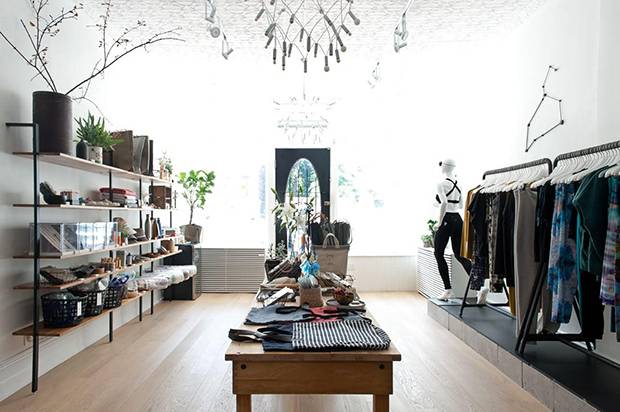The interior of Ease is decorated in pale hues, and accented by artfully placed plants and soothing abstract paintings in gentle tones. Slim black hangers hold an assortment of monochrome bags, t-shirts and jackets on matching matte racks. Each piece is spaced generously, precisely apart, like objects in a gallery. The back half of the store is even more sparsely populated: an upholstered blue bench, a slim white coffee table, a glossy white counter. It's a minimalist fantasy world where everything is clean, austere and beautiful. In a lot of ways Ease, which opened this past summer in Toronto's Little Portugal, is what independent fashion retail looks like in 2017. Whether it works for customers, however, is yet to be seen.
From the rise of tiny homes to the designer basics on offer at chains like COS and Uniqlo, minimalism is having a major moment. But unlike those brands, whose stores are abundant with unfussy apparel and accessories, Ease and a growing number of other boutiques offer a thoroughly vetted – or what many call "curated" – selection of clothes, accessories and decor designed to accentuate a clutter-free lifestyle. In the cutthroat world of fashion retail, where costs are high and in-store sales are challenged by online competitors, clean lines and sparsely arranged product can seem at odds with profitability.
Ease owner Zai Rajkotwala supplements her physical store with an online business.
"I do really have to catch myself, because I have to target a very specific customer," says Zai Rajkotwala, the owner of Ease, who guesses she could comfortably fit three times as much product into her store's 1,000 square feet. "I want to cater towards the modern, minimal creative woman," she says. "The Ease woman wears a white t-shirt, leather jacket, lipstick… she keeps it very simple."
For as long as shopping has existed, a primary means of measuring a store's success has been sales per square foot, the relationship between the amount of product a business is moving and how much space it uses to display it. Less space to display generally means less product to buy, which means less revenue. Factor in the cost of rent on prime shopping streets – particularly for small independent retailers – and the formula begins to strain.
Rajkotwala guesses she could fit three times as much product into Ease’s 1,000 square feet.
"The store design does influence how much product you can have," says Ani Nersessian, founder of VM-iD, a visual merchandising company. For mass-market fast fashion brands like H&M and Zara, she says, customers expect piles of ever-changing product at low prices and profits are dependent on high-volume sales. Apple, whose streamlined products and sleek advertising campaigns brought minimalist design to the masses, leads the world in sales per square foot, at a staggering $5,546 according to a 2017 report. As a result boutiques like Ease, whose customers are drawn to similarly spare shelves and white space, have to make up for this missing inventory by offering items with more hefty price tags.
On Roncesvalles Avenue, the main shopping street in a tree-lined residential Toronto neighbourhood, Ardith's shelves display a similar selection of curated lifestyle pieces. The shop's Victorian storefront is in a prime location, and its 500-square feet could hold far more than its handful of colour-blocked leggings, tote bags and artfully packaged wellness products, but like Ease, Ardith's brand is built on the idea that less is more, and their products' quality is worth the premium price. "The real focus is products that are special, that are made sustainably and ethically and good for the value," says owner Miranda Bryden, who tests all of her wares personally. "It's not that I'm imposing this environment on customers," she says. "They expect and demand it. It's not about acquiring things or stuff, it's style of life… being really choosy about what you buy and buying less."

Ardith owner Miranda Bryden says her customers expect a well-edited selection.
Rajkotwala's product follows a similar philosophy of quality over quantity, but she acknowledges the challenge of generating good sales numbers from less inventory, even if that product includes $100 T-shirts and $1,400 leather jackets. Her rstore, however, isn't intended to be the core of her business. "The store is more of a gallery space, educating people about the products, and online can be a wider platform to reach more people," she says.
Targeting customers both at home and abroad, in part via an Instagram feed of beautifully composed minimalist tableaux, Rajkotwala hopes to do 70 per cent of her business online and the remaining 30 per cent in-store. Ardith, which opened in 2015, has so far stayed afloat by in-store visits from a loyal local customer base. Bryden is, however, considering renting out part of her floor space to a local handbag brand, subsidizing her rent by stocking a product she already likes. "The minimalist thing is here to stay," she says. "Rent gets higher and higher, so shop owners are going to do interesting things to maintain the aesthetic and ensure the survival of their business."
Visit tgam.ca/newsletters to sign up for the Globe Style e-newsletter, your weekly digital guide to the players and trends influencing fashion, design and entertaining, plus shopping tips and inspiration for living well. And follow Globe Style on Instagram @globestyle.